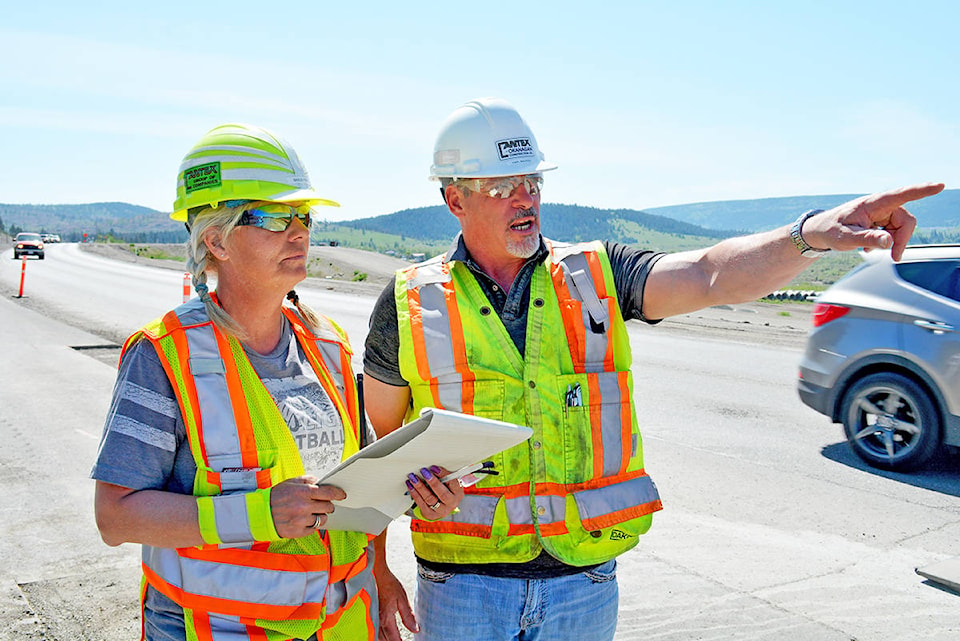Commuters are not the only ones trying to maintain their patience as work resumes on the Highway 97 four-laning project near Williams Lake Indian Band.
Earl MacLeod, superintendent of the project for Cantex Okanagan Construction Ltd., said if it wasn’t for the 2017 wildfires, his crews would be adding the finishing touches by now.
Instead, the project started up again on May 7, after some preliminary work to make the road passable.
It is hoped the project will be completed by fall 2018.
“During the fires we couldn’t pave and later we had some heavy smoke days and we couldn’t actually put people to work under legal requirements,” MacLeod said. “When we did get back to work it was late in the season and we had our struggles with the asphalt.”
Last year after the fires, the work was restricted, he added.
“It was a mad rush at the end and we were going 24/7 with crews on site. We realize we impacted the local traffic quite a bit.”
Drainage was also a concern, he explained.
Because they had built the highway up to a certain point, temporary drainage was required in some areas, and in other areas where they had done bigger excavations.
“We actually ended up laying pavement over some of the culverts and we were hauling materials from Kamloops and Quesnel in -12C and -14C temperatures just to get them work done.”
There were also some minor blowouts of the new pavement during the winter that had to be milled under the direction of the Ministry of Transportation and Infrastructure, he added.
The entire construction plan had to be changed as a result of the delays, he said.
Presently 43 people are working on site and on Monday crews began to pave some patches that are required to keep people driving through the site during the remaining construction.
There will be some short stoppages when full construction is underway, but the plan is to use crossovers instead of using the travel lanes as construction lanes, MacLeod explained.
Unfortunately sometimes flaggers have received backlash from the public with half-empty water bottles and cigarette butts thrown at them, and lots of people are speeding through the 50 km/h zone, Mac-Leod said.
“We understand how people feel and the frustration behind it all, but the speed limit is there for a reason.”
There are lots of good people coming through as well, he added, noting crews are holding their chins up and doing the best they can.
“It’s tough because some of them live in this neighbourhood,” MacLeod said.
“The struggles we are having are not their fault. It was an Act of God and we are all feeling the effects of it now.”
Aside from the wildfires, and wrath from some drivers, the project has also faced vandalism.
On the evening of Sunday, May 13, three paving trucks had all of their windows smashed, which unfortunately, MacLeod said, occurred in between video surveillance timers so there’s no footage of the vandalism.
The RCMP came out to investigate, but so far have not found any suspects, while the damage is estimated to be around $10,000.
“We’ve also had five high-speed chases through this site in the last two weeks with vehicles travelling at 140 to 160 km/h,” MacLeod added.
Highway crew’s
wildfire response
When the fires broke out on July 7, the highway crew sprang into action.
“We had about 25 people on site so on the first night we secured the Chief Will-Yum Gas Bar,” MacLeod recalled.
Crews worked into the night with bulldozers to build a fire guard up as far as the powwow arbor.
The highway crew also went up to Virgina Gilbert’s home on Moose Drive on the upper side of the highway, but when the fire started coming over the hill, MacLeod didn’t think they had a chance to fight it.
In the end, Gilbert’s house escaped the fire, although outbuildings on her property did not.
MacLeod worked with the Ministry of Forests when he was younger and has been called in with different equipment through the years, but said 2017’s fires were unprecedented.
“I’ve seen fire up close and I’ve never seen it react like that,” he said.
“It was moving so fast and so hot. It was unreal. There were embers landing the size of hardhats and the winds were phenomenal.”
Cantex kept two water trucks going with its own ground crews fighting fires up until the evacuation of the city of Williams Lake on July 15.
Many of the employees were out on evacuation order from their homes, with their own homes threatened, but still came to work under a stressful situation, he added.
“Some of our people didn’t return after the fires because they had found other employment. It impacted our crew and a lot of people’s mentalities.”
Cantex didn’t lose any equipment to the 2017 wildfires, although a few hoses, silt fences and environmental controls that were burned had to be replaced.
“We were really lucky actually,” MacLeod said.
